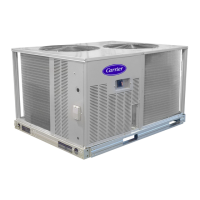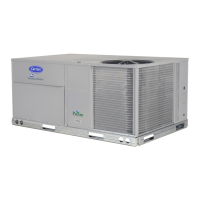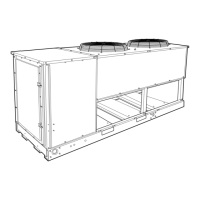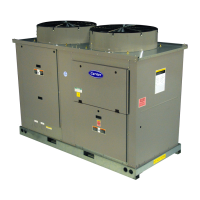20
Step 9 — Wind Baffles for Low Ambient Control
Models 38AUZB and 38AUDU include the factory installed
32LT Motormaster
®
Low Ambient Control.
Units with 32LT Motormaster control require the addition of wind
baffles to ensure full range low ambient operation. Material data
and dimensions for wind baffles are included in Appendix C, Low
Ambient Control, starting on
page 56. Fabricate the wind baffles
and mount per instructions.
PRE-START-UP
System Check
1. The electrical power source must agree with the unit’s name-
plate rating.
2. Check all air handler(s) and other equipment auxiliary com-
ponents. Consult the manufacturer’s instructions regarding
any other equipment connected to the condensing unit. If the
unit has field-installed accessories, be sure all are properly
installed and correctly wired. If used, the airflow switch must
be properly installed.
3. Check tightness of all electrical connections.
4. Be sure liquid line and low side of the system are properly
leak checked and dehydrated.
5. Be sure the unit is properly charged. See “Preliminary
Charge”, below.
6. Open the liquid line and suction line service valves.
7. The crankcase heater must be firmly attached to the compres-
sor crankcase. Be sure the crankcase is warm (heater must be
on for 24 hours before starting compressor).
Turn On Crankcase Heater
Turn on the crankcase heater for 24 hours before starting the unit
to be sure all the refrigerant is out of the oil. To energize the crank-
case heater, proceed as follows:
1. Set the space thermostat set point above the space tempera-
ture so there is no demand for cooling.
2. Close the field disconnect.
Preliminary Charge
Before starting the unit, charge liquid refrigerant into the high side
of the system through the liquid service valve. The amount of re-
frigerant added must be at least 80% of the operating charge listed
in the Physical Data table (Tables 4 and 5). Allow high and low
side pressures to equalize before starting compressor. If pressure
do not equalize readily, charge vapor on low side of system to as-
sure charge in the evaporator. Refer to GTAC II, Module 5,
Charging, Recover, Recycling, and Reclamation for liquid
charging procedures.
START-UP
The compressor crankcase heater must be on for 24 hours before
start-up. After the heater has been on for 24 hours, the unit can be
started. If no time elapsed since the preliminary charge step was
completed, it is unnecessary to wait the 24-hour period.
Preliminary Checks
1. Check that electric power supply agrees with unit nameplate
data.
2. Verify that the compressor crankcase heater is securely in
place.
3. Check that the compressor crankcase heater has been on at
least 24 hours.
4. Recheck for leaks using the procedure outlined in the
Pre-Start-Up section, Leak Test and Dehydration. If any
leaks are detected, repair as required. Evacuate and dehy-
drate as described in the Leak Test and Dehydration section.
5. Ensure that the preliminary charge has been added as
described in the Pre-Start-Up section, Preliminary Charge.
6. All internal wiring connections must be tight, and all barriers
and covers must be in place.
NOTE: The 38AU units are factory charged with the required
amount of oil. If recharging is required, use Emkarate
RL 32-3MAF for the 38AU units.
COMPRESSOR ROTATION
On 3-phase units with scroll compressors, it is important to be cer-
tain that the compressor is rotating in the proper direction. 38AU
units are equipped with a Comfort Alert Diagnostic Module
(CADM). Alert Code 7 indicates reverse power phasing.
To correct phase order:
1. Turn off power to the unit, tag disconnect.
2. Reverse any two of the unit power leads.
3. Reapply power to the compressor, verify correct pressures.
To verify the compressor is rotating in the proper direction:
1. Connect service gauges to the suction and liquid pressure
fittings.
2. Energize the compressor.
3. The suction pressure should drop and the liquid pressure
should rise, as is normal on any start-up.
COMPRESSOR OVERLOAD
This overload interrupts power to the compressor when either
the current or internal motor winding temperature becomes
excessive, and automatically resets when the internal tempera-
ture drops to a safe level. This overload may require up to 60
minutes (or longer) to reset. If the internal overload is suspected
of being open, disconnect the electrical power to the unit and
check the circuit through the overload with an ohmmeter or con-
tinuity tester.
ADVANCED SCROLL TEMPERATURE PROTECTION
(ASTP)
A label located above the terminal box identifies Copeland™
1
Scroll compressor models that contain this technology. See
IMPORTANT: Before beginning Pre-Start-Up or Start-Up,
review Start-Up Checklist at the back of this book. The Check-
list assures proper start-up of a unit and provides a record of
unit condition, application requirements, system information,
and operation at initial start-up.
CAUTION
UNIT DAMAGE HAZARD
Failure to follow this caution may result in equipment damage.
Do not attempt to start the condensing unit, even momentarily,
until the following steps have been completed. Compressor
damage may result.
CAUTION
UNIT DAMAGE HAZARD
Failure to follow this caution may result in equipment damage.
Prior to starting compressor, a preliminary charge of
refrigerant must be added to avoid possible compressor
damage.

